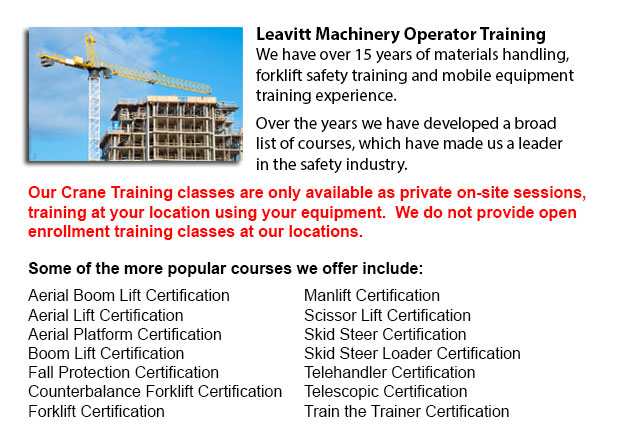
Overhead Crane Safety Training Mississauga - The overhead crane safety training program is intended to equip the operators with the right knowledge and skills in the areas of: crane safety measures, accident avoidance, materials handling, and equipment and stock protection. Each of the trainees would get to learn on many types of overhead cranes, their capabilities and their uses in different settings. For operators who are trained and licensed, the shift in liability moves to the operator from the company. Hence, the program emphasizes individual operator responsibilities.
Overhead crane safety training instructs operators in the correct ways for performing checks. Two kinds of pre-shift check are the in-depth inspection and the walk-around inspection. These are critical daily routines which should be logged. Correctly recorded pre-shift checks help to protect the business from liability in the event of an accident. Pre-shift inspections also prevent accidents, damage and costly repairs. Operators learn how to designate a specific person to perform checks, how to maintain the log book and how to report problems.
Inspections must be performed often and documented properly. The following should checked while watching for usual problems: hooks for cracks, increases in the throat opening, degree of twist; hoist ropes for corrosion, loss of diameter, worn wires, broken wires, bird caging and kinks, heat and chemical damage; chains for gouges and nicks, twists, cracks and corrosion, distortion, excessive wear, pits, stretching, damage from extreme heat.
Operators learn correct rigging measures in this course. Rigging involves understanding the manufacturer's data plate, determining the weight of materials to be lifted, choosing the gear, and utilizing safe practices to secure the load. The program cover in detail the following: safe working loads, and the capacities of ropes, chains, slings, hooks and shackles.
It is important to understand who can operate the cranes at your facility, physical requirements of the job, and operator credentials needed for permits and specialized tasks. Safety should be prioritized when using near pedestrian traffic.
Safe crane utilization consists of responsibilities like checking for hydraulic leaks, undertaking visual inspections, testing the controls, checking the safety guards, examining the hook and hoist rope, limit switches and braking mechanisms. Right reporting methods are vital. These topics are all covered in depth in the program.
Right moving and lifting procedures with cranes and hoists are included in the program. Operators will become knowledgeable in hand signals. Training includes how to attach the load, raise the load, abort a lift, set the load and unhook the slings.
Moving the load involves some steps: starting and stopping procedures, controlling and guiding the load, working with signals and observing working conditions. Operators need to know how to proceed in case of a power failure. The course covers techniques for lowering the load and removing the slings, parking the crane, storage equipment, and securing an indoor and outdoor crane.
-
Forklift Certification Courses Mississauga
Forklift Certification Courses Mississauga - Forklift certification courses really help to be able to make certain that businesses operating forklifts, follow the local and regional rules. The operators of the forklift must go through forklift certif... More -
Heavy Equipment Certification Mississauga
Heavy Equipment Certification Mississauga - Big pieces of machinery and heavy-duty vehicles are often referred to as heavy equipment. This broad term covers utility vehicles from agricultural and forestry implements to construction equipment, civil e... More -
Skid Steer Loader Training in Mississauga
The engine powered skid-steer loader has a rigid and small frame, outfitted together with lift arms that can attach to lots of industrial attachments and tools to perform numerous labor saving tasks. Usually, skid-steer loaders are four-wheel drive v... More -
Bucket Truck Training Mississauga
Bucket Truck Training Mississauga - The Vehicle-Mounted Aerial Work Platform or bucket truck training program is designed to decrease the possibility of incident and personal injury when working with or in close proximity to bucket trucks by efficien... More -
Scissor Lift Certification Mississauga
Scissor Lift Certification Mississauga - Scissor lift platforms are used at work locations to enable tradespeople - like for example welders, masons and iron workers - to reach their work. Utilizing a scissor lift platform is typically secondary to t... More -
Order Picker License Mississauga
Order Picker License Mississauga - Order preparation operation or order picking as it is more normally known is a process used within warehouse operations and comprises personnel called order pickers. The order picker's job is to take and collect art... More -
Forklift Train The Trainer Mississauga
Forklift Train The Trainer Mississauga - Our company provides the most advanced and latest Forklift Training courses in North America. We provide industrial workplace safety training, Train the Trainer, mobile equipment operator, and self study train... More -
Aerial Platform Training Mississauga
Aerial Platform Training Mississauga - Aerial forklifts are able to accommodate numerous odd jobs involving high and tricky reaching spaces. Normally utilized to execute daily maintenance in buildings with tall ceilings, trim tree branches, hoist hea... More

Forklift Training Mississauga
TOLL FREE: 1-888-254-6157
Mississauga, Ontario
forklifttrainingmississauga.ca
Email Us
About Us


